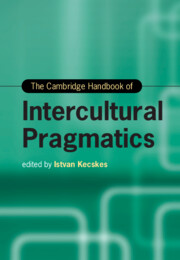Book contents
- The Cambridge Handbook of Intercultural Pragmatics
- Cambridge Handbooks in Language and Linguistics
- The Cambridge Handbook of Intercultural Pragmatics
- Copyright page
- Contents
- Figures
- Tables
- Acknowledgment
- Contributors
- Introduction The Rise of Intercultural Pragmatics
- Part I Theoretical Foundation
- Part II Key Issues in Intercultural Pragmatics Research
- Part III Interface of Intercultural Pragmatics and Related Disciplines
- 15 Semiotics and Intercultural Pragmatics
- 16 Sociopragmatics and Intercultural Interaction
- 17 Intercultural Pragmatics from the Perspective of English as a Lingua Franca
- 18 Intercultural Rhetoric
- 19 Politeness and Rapport Management
- 20 Corpus Pragmatics: Corpus-Based Intercultural Pragmatic Research
- Part IV Intercultural Pragmatics in Different Types of Communication
- Part V Language Learning
- Index
- References
15 - Semiotics and Intercultural Pragmatics
from Part III - Interface of Intercultural Pragmatics and Related Disciplines
Published online by Cambridge University Press: 29 September 2022
- The Cambridge Handbook of Intercultural Pragmatics
- Cambridge Handbooks in Language and Linguistics
- The Cambridge Handbook of Intercultural Pragmatics
- Copyright page
- Contents
- Figures
- Tables
- Acknowledgment
- Contributors
- Introduction The Rise of Intercultural Pragmatics
- Part I Theoretical Foundation
- Part II Key Issues in Intercultural Pragmatics Research
- Part III Interface of Intercultural Pragmatics and Related Disciplines
- 15 Semiotics and Intercultural Pragmatics
- 16 Sociopragmatics and Intercultural Interaction
- 17 Intercultural Pragmatics from the Perspective of English as a Lingua Franca
- 18 Intercultural Rhetoric
- 19 Politeness and Rapport Management
- 20 Corpus Pragmatics: Corpus-Based Intercultural Pragmatic Research
- Part IV Intercultural Pragmatics in Different Types of Communication
- Part V Language Learning
- Index
- References
Summary
Human conversation is an extremely intricate social ritual that involves the strategic utilization of signs and sign systems that will ultimately determine how it will unfold successfully or not. When two people speak the same language and belong to the same culture they automatically can plug into the same semiotic codes (language, facial expression, relevant cultural allusions, etc.) that ensure the flow of meaning exchanges, thus determining the outcome of the conversation. What happens when the interlocutors speak different languages and belong to different cultures, yet engage in conversation through a common language, which may or may not be spoken by either one of them as a native language? In such situations the codes that regular conversations may trigger meaning anomalies that lead to unanticipated reactions or misunderstandings. This chapter looks at the problem of intercultural communication from the perspective of semiotic method, focusing on the semiotic codes (verbal and nonverbal) involved in any interaction.
Keywords
- Type
- Chapter
- Information
- The Cambridge Handbook of Intercultural Pragmatics , pp. 397 - 419Publisher: Cambridge University PressPrint publication year: 2022

